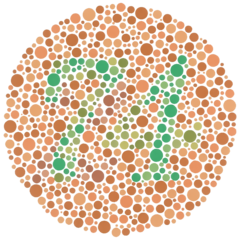Perhaps so to the motorist, but what about a search plane looking down on the sea...? I'd think that yellow or oragne would contrast the best?
I respect everyone's right to have an opinion. I try hard to base my opinions on sound research and facts so I pass along the following for consideration. If someone can assist me by providing sound evidence that another color is better, please pass the informaton along. I am NOT a scientist and I "don't have a horse in this race" so I will yield to others who know more than I. This is what I was able to find online this evening in an effort to support what I have been told over recent years.
Respectfully,
Blades Robinson
= = = = = = = = = = = = =
Can you see a number inside the diagram below?

The number "74" should be clearly visible to forum readers with normal color vision. Forum members with dichromat or anomalous trichromat may read it as "21", and viewers with achromat may see nothing.
From: http://www.wastesafety.com/safety.htm
The April 2000 issue of Utility Safety states that the lime-yellow fluorescent color provides better visibility to distinguish humans in a cluttered work zone. Furthermore, a red/green colorblind person (which includes a large portion of males) sees orange fluorescent as black in sodium light, which is increasing in usage on some roadways.
The lime-yellow fluorescent color is seen more clearly and more brightly than the orange fluorescent color.
CAT.INST http://cat.inist.fr/?aModele=afficheN&cpsidt=2064027
The relative conspicuities of six test garments (fluorescent orange, green/red, high-contrast, fluorescent lime-yellow, white, black) were assessed to guide the selection process of a standard upper body safety garment to be used within the New Zealand logging industry. Six male and four female participants, aged between 18 and 26 years, volunteered to perform 10 trials each on a demanding, central (tracking) task, while peripherally searching colour slides for test garments displayed on each of eight positions, against a pine forest background typically found in the New Zealand forestry. During each trial, transparency luminance was first gradually increased from darkness to daylight and then decreased to darkness again within 180 s. A head mounted ASL eye tracking system (4000SU) recorded the eye line of gaze for each participant, enabling a rank order of detection to be obtained for the tested garments in each trial. The fluorescent lime-yellow, fluorescent orange and white test garments were detected earlier than any other test garments across all trials, and
the fluorescent lime-yellow test garment was detected first with a higher frequency than the white test garment. It was concluded that while white may be the most visible colour in near darkness conditions, as it provides highest contrast, fluorescent lime-yellow stands out better in twilight and daylight conditions against the pine forest background. The results of this study led to the promotion of fluorescent lime-yellow as the standard safety colour used in upper body garments within the New Zealand forest industry.
The Complete Color Harmony: Expert Color Information (page 34)
Lime green is the ideal choice for billboards or equipment that needs to be seen at night.
Research has proven that flourescent lime is the most visible color in the dark as well as in poor weather conditions such as fog.
In fact, safety research studies of fire engines found that when they were painted lime green, the trucks were involved in half the number
= = = = = = = = = = =
Based on the information above and information that I have read over recent years, I am of the opinion that lime green, day-glo green, or flourescent green is the most easily seen color in nearly all conditions.




